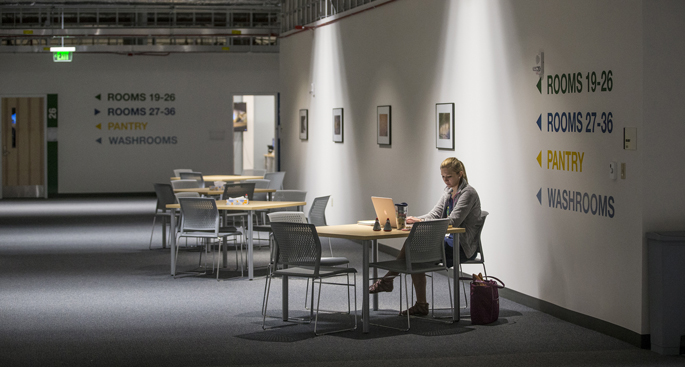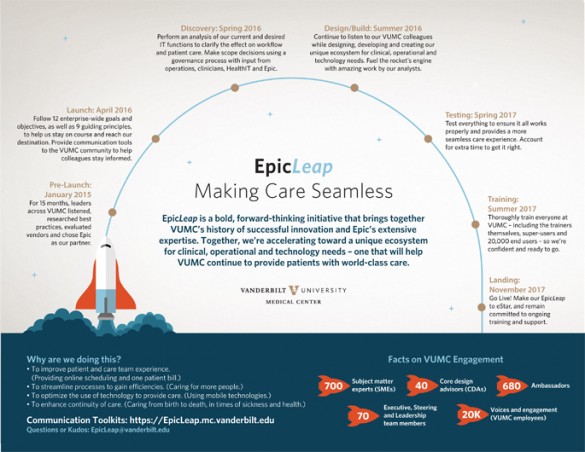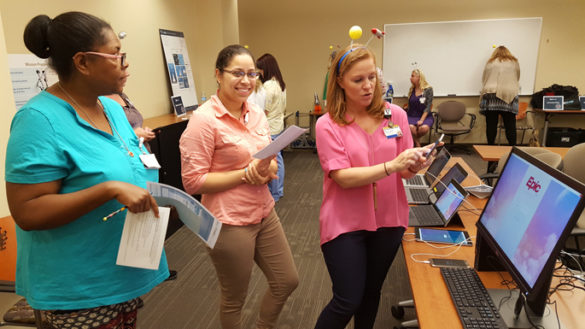
Training an entire organization on how to use a new computer system isn’t a simple task — especially when it involves adequately training more than 17,000 employees during a span of just 10 weeks.
Vanderbilt University Medical Center’s (VUMC) decision to approach the transition to eStar as a “Big Bang” implementation — which means nearly every location will begin to use eStar on the same day — demanded an intensely coordinated approach to training. On Nov. 2, every employee who will need access to eStar must be ready to use the new software in a real-life patient care setting.
“It’s a huge balancing act,” said Cory Colton, VUMC’s executive director of learning and development and the training lead for the EpicLeap program.
“You need enough runway to get thousands of people trained in time, but you can’t train them too early, or you risk them not retaining their new knowledge and skills.”
In order to prepare for this effort, the team had to devise an integrated strategy surrounding how the training curriculum would be created, where training would take place, who would lead it, how employees would be transported to various training locations, and other details necessary to ensure the project’s success.
Two training approaches to maximize adoption
One of the earliest decisions made by the EpicLeap Training team was to divide training into two complementary approaches. The first will deliver training to most of VUMC’s staff members and reflects a traditional, instructor-led approach. The second, based on observations and best practices from recent Epic implementations at similar academic medical centers, is being used to train VUMC’s nearly 4,000 physicians, advanced practice nurses, clinical residents and fellows. Known as the Peer Training Model, it allows VUMC providers to learn how to use eStar directly from their peers.
The Peer Training Model maximizes the efficiency of the training effort by grouping clinical specialties together into “cohorts,” which are based on common workflows and specialty areas, or modules, of eStar, to deliver training that is relevant to each provider. According to Dara Mize, M.D., who is helping to lead the peer training effort, “Providers learning directly from their peers will shorten the adoption curve for eStar and its workflows.”
Creating classroom curriculum
Another critical undertaking for the training effort was developing the list of classes that would be offered and the particular content, or curriculum, of each one of those classes. Twenty-five Principal Trainers, or PTs, led this work. Armed with Epic’s base training curriculum and knowledge of the hundreds of new operational workflows designed as part of EpicLeap, the PTs created curriculum that best suits VUMC’s needs.
Their task involved determining what Vanderbilt’s diverse groups of faculty and staff would need to know about each application in order to use eStar effectively in their areas of practice, and then building a training curriculum to provide that knowledge. In a few situations, the PTs even had to create completely customized classes that weren’t included in Epic’s base training curriculum, such as the classes developed for VUMC’s LifeFlight program.
“End users will be able to have targeted training that’s specific to their roles and their needs, and that will result in a more individualized learning experience for them—and also for a more streamlined class time,” said Meg Gaither, an Epic-experienced training consultant who is working with VUMC. “Everything will be customized just for that group.”
After completing the majority of the curriculum build, the training team invited employees who have been heavily involved in the project to participate in Pilot Training. These participants were able to preview the lessons and provide feedback. The PTs then took feedback from these sessions into consideration and made changes in the curriculum where they saw fit.
With a final course catalog, an understanding of each course’s content, and a detailed list of the more than 17,000 people who would need to be trained, the team’s next step was to figure out the class schedule. To ensure everyone receives training before Go Live, a creative solution would have to be applied, which meant training from early in the morning to nearly midnight every day of the week (including weekends).
“Some teams prefer the night and weekend classes,” Colton said. “It meant that they didn’t have to make any adjustments to normal operations and could get everyone trained before Nov. 2.”
Special training centers
In addition to the “what” and the “when,” another important challenge was the “where.” With factors such as location convenience in mind, the team began construction on two new, first-class training centers — located inside VUMC’s Critical Care Tower and at One Hundred Oaks Mall. There are 50 classrooms in total, with each seating roughly 15 employees, allowing for the potential of training approximately 750 employees at once. The team worked alongside designers to make the space as comfortable as possible, with plenty of room for employees to pull out their laptops and work or eat lunch during breaks.
Once the locations of the training centers were selected, the EpicLeap Training Team developed a parking and transportation plan to accommodate employees who would attend training away from their primary work location. For example, a dedicated parking lot is reserved at the Nashville Fairgrounds for those training at One Hundred Oaks. Shuttles have been scheduled to run between the Fairgrounds and the training center entrance every 15 minutes from 5:45 a.m. to 11:30 p.m. on weekdays. Security personnel will monitor the lot during this time to help ensure employee safety.
Putting all the pieces together
One of the final pieces of the training puzzle was who would lead the training for each classroom session.
A diverse group of trainers was recruited to lead each class, each coming to VUMC as a new hire, as a colleague “on loan” from another VUMC area who will return to their permanent team after Nov. 2, or as an expert consultant who has led training in other Epic implementations.
Known as Credentialed Trainers, these individuals received in-depth education earlier this summer on eStar and its workflows. Many of them will provide classroom support for Peer Trainers as part of the provider-specific training approach.
The assembled puzzle will offer VUMC colleagues a valuable training experience that will be relevant to their specific role and responsibilities. Before each class, employees will complete a set of eLearnings, web-based learning modules that provide exposure to the important fundamentals of eStar. This allows for more class time to be spent on complex topics and workflows.
After each class, colleagues will take a short test that will ensure they have the skills and knowledge to support excellent patient care on Nov. 2. They will also have access to the “playground,” a specially built environment of eStar populated with fictionalized, but realistic, patients. The team will also host a series of Cyber Cafes, where employees can log into the playground and practice their new skills with trainers on hand for support and guidance.
Colton recommends employees spend at least two hours in the playground, noting, “Being able to practice everyday tasks before Go Live will be especially comforting for anyone who may be nervous about making the transition.”
The EpicLeap Team feels ready and confident in its ability to effectively train colleagues on how to use the new system. With the active participation and effort of all employees in ensuring the success of the training phase, VUMC will be one step closer to a smooth and seamless Go Live and beyond.














